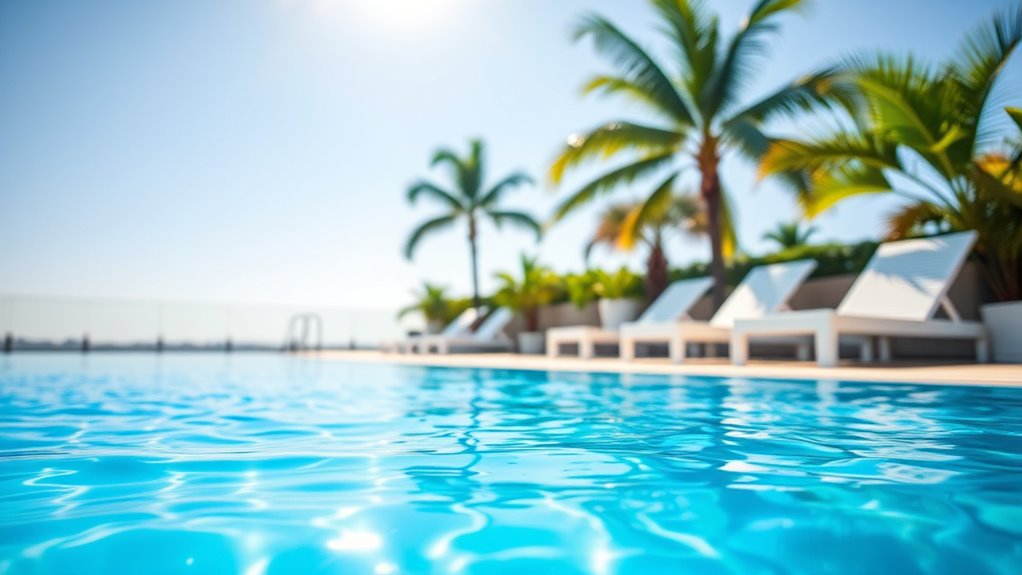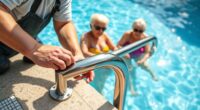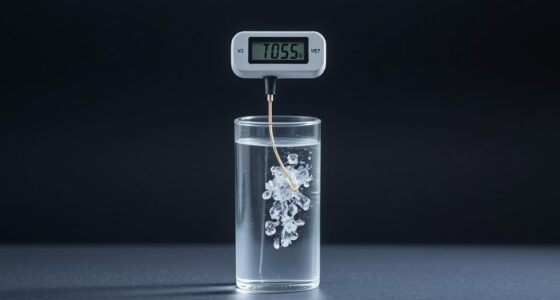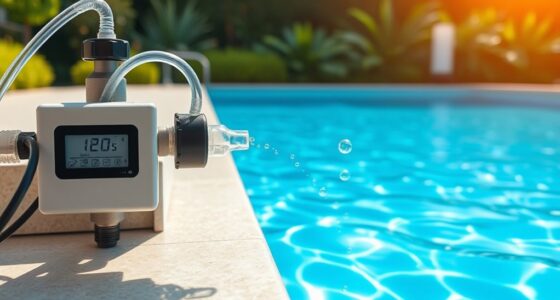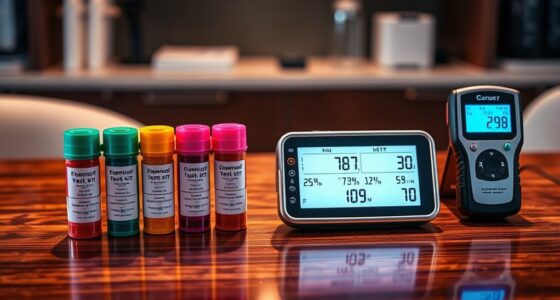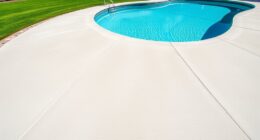Chloramine odors in your pool happen when chlorine reacts with organic contaminants like sweat, oils, or debris, creating unpleasant fumes. To fix this quickly, increase water circulation, improve filtration, and balance your chlorine and pH levels. Shocking the pool with a high dose of chlorine can break down chloramines fast. Keeping organic debris out and maintaining proper chemistry prevents future issues. Learn more tips to keep your pool fresh and odor-free.
Key Takeaways
- Chloramine odors result from chlorine reacting with organic contaminants like sweat, urine, and debris in the pool.
- Insufficient filtration, poor circulation, and imbalanced pH promote chloramine buildup and odors.
- Rapid fixes include increasing water circulation, shocking with high chlorine, and using activated carbon filters.
- Regular testing and balancing chlorine, pH, and alkalinity prevent chloramine formation and maintain water clarity.
- Encouraging pre-swim hygiene and proper maintenance reduces organic contaminants and minimizes odors.
Understanding Chloramines and How They Form

Chloramines are compounds that form when chlorine used in pools reacts with organic substances like sweat, urine, or skin cells. When you swim, these substances enter the water and interact with the chlorine present. Instead of safely disinfecting, the chlorine binds to nitrogen in these organic materials, creating chloramines. This process happens more quickly if the water isn’t properly maintained or if many swimmers are in the pool. As chloramines develop, they produce the strong, unpleasant smell often associated with pools, but it’s actually a sign of contamination, not cleanliness. Understanding how chloramines form helps you recognize why proper pool maintenance is essential. Keeping chlorine levels balanced and encouraging hygiene reduces chloramine buildup, making your swim safer and more enjoyable. Proper circulation and regular water testing are also crucial in controlling chloramine levels effectively, as water circulation helps distribute chemicals evenly and prevent localized buildup. Additionally, implementing adequate filtration can help remove organic contaminants more efficiently, further reducing chloramine formation. Ensuring proper filter maintenance is vital for maintaining water quality and minimizing chloramine formation.
Signs of Chloramine Buildup in Your Pool
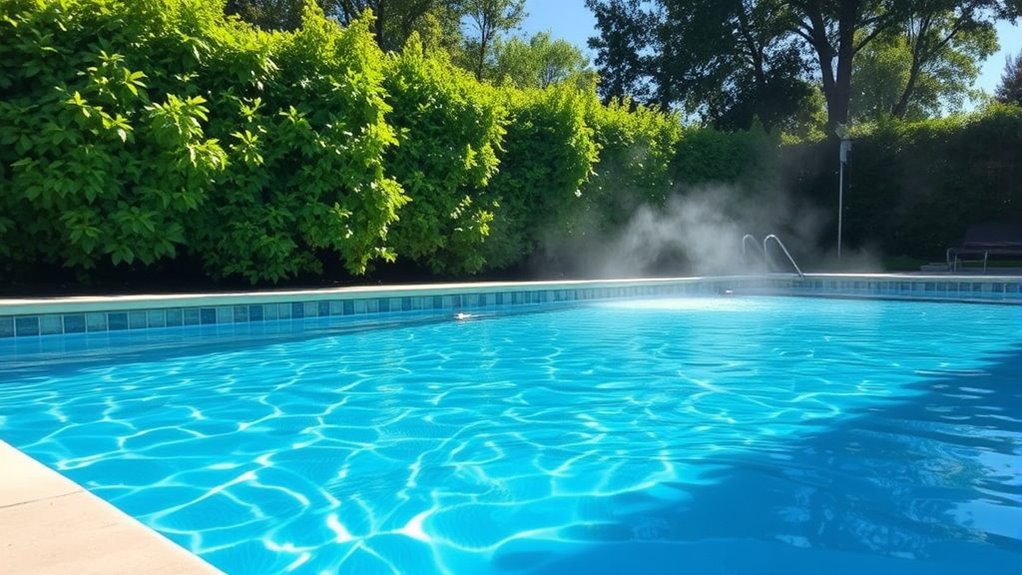
If you’ve noticed a strong, chlorine-like smell around your pool, it could be a sign that chloramine levels are rising. This odor indicates that chloramines are accumulating, often due to insufficient free chlorine. You might also observe:
- Cloudy or murky water
- Skin or eye irritation after swimming
- A persistent, chemical smell even after shocking the pool
- Reduced water clarity
- A slight haze on the pool surface
These signs suggest that your pool isn’t properly sanitized and chloramine levels are building up. Ignoring these signals can lead to uncomfortable swimming conditions and compromised water quality. Staying alert to these indicators helps you take quick action to restore clear, fresh water and a more enjoyable swimming experience. Additionally, understanding water treatment practices can help prevent chloramine buildup in the future. Proper water chemistry management is essential for maintaining a healthy swimming environment and preventing issues related to chloramine accumulation, such as oxidation of contaminants. Regular testing and balancing of your pool’s chemical levels can further reduce the risk of chloramine formation, and being aware of the signs of buildup can help you address problems early, ensuring safer and more pleasant swimming conditions.
The Impact of Chloramines on Your Swimming Experience
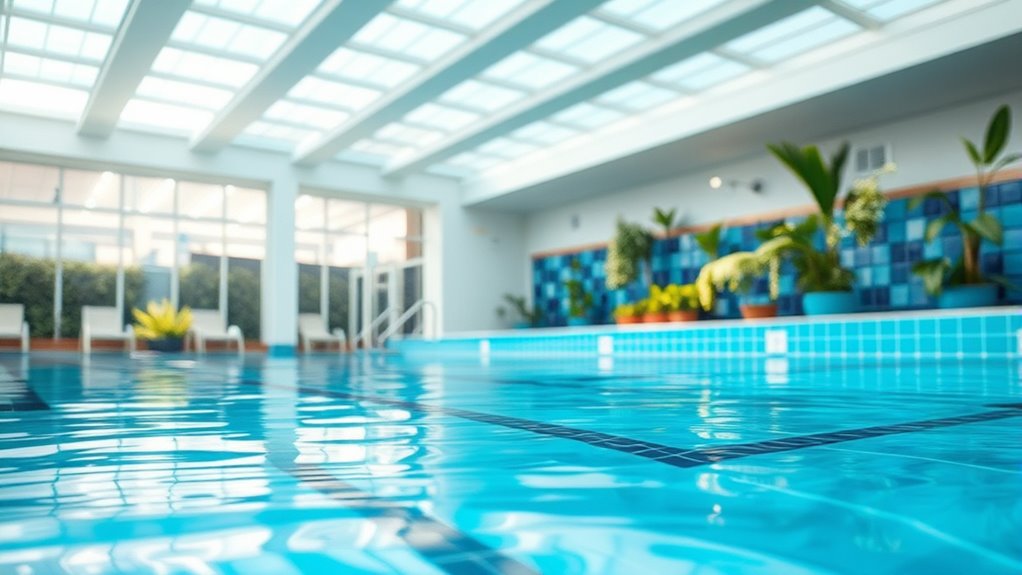
When chloramines build up in your pool, you might notice breathing becomes harder and your eyes or skin feel irritated. These issues can make your swimming experience uncomfortable and less enjoyable. Understanding how chloramines affect you helps you take action to improve your time in the water. Proper water quality management, including regular testing and treatment, is essential to minimize chloramine levels and maintain a safe swimming environment. Elevated chloramine levels can also indicate inadequate filtration systems, which are crucial for maintaining water clarity and safety. Effective filtration, especially models with advanced HEPA filters, can help remove contaminants that contribute to chloramine formation, enhancing overall water quality. Maintaining proper vibrational energy around water and in your environment can also support healthier water conditions and improve your swimming experience.
Breathing Difficulties in Pool
Breathing in a pool with high chloramine levels can cause noticeable discomfort and even health problems. You might experience coughing, shortness of breath, or a tight chest, especially during prolonged exposure. Chloramines irritate your respiratory system, making breathing feel labored or uncomfortable. This can ruin your swimming experience and pose health risks over time. To minimize these issues, consider the following:
- Swim in well-ventilated pools
- Limit your time in indoor pools with strong chloramine odors
- Avoid inhaling deeply near the water surface
- Use a mask if you’re sensitive to airborne chemicals
- Encourage pool staff to improve water circulation and filtration
- Regular water testing and proper chloramine removal techniques ensure healthier swimming conditions. Proper water treatment methods are essential for controlling chloramine levels effectively. Additionally, understanding the air quality in indoor pools can help identify potential health hazards related to chloramine buildup. Monitoring air exchange rates can significantly reduce indoor chloramine concentrations and improve overall air quality.
- Staying informed about emerging AI technologies can also aid in developing better water treatment solutions through advanced data analysis.
Skin and Eye Irritation
Chloramines in pool water don’t just irritate your respiratory system; they can also cause uncomfortable skin and eye problems. When chloramines build up, they can lead to redness, itching, and a burning sensation on your skin. Your eyes might become red, teary, and sensitive to light, making swimming less enjoyable. These irritations happen because chloramines are harsh chemical compounds that cling to your skin and eyes, disrupting their natural balance. To minimize discomfort, shower thoroughly before swimming to wash off any chloramine residues. Regularly testing and maintaining proper chlorine levels can help reduce chloramine formation. Using a quality pool filter also plays an essential role in keeping chloramine levels low, allowing you to enjoy your swim without irritation. Proper f pool maintenance practices are crucial in preventing chloramine buildup and ensuring a safe swimming environment.
Common Sources of Organic Contaminants in Pools

You bring organic contaminants into the pool through sunscreen, lotions, sweat, and body oils. Organic debris like leaves and dirt can also accumulate over time. These sources contribute to chloramine formation and affect your swimming experience. Proper disposal practices can help minimize additional contamination in the pool water. Additionally, maintaining proper circulation and filtration systems can further reduce the buildup of organic contaminants and improve water quality. Regular cleaning and water testing are essential to detect and address chemical imbalances caused by organic buildup.
Sunscreen and Lotion Residues
Sunscreen and lotion residues are common sources of organic contaminants in pools, often entering the water when swimmers apply these products before swimming. These residues contain oils, chemicals, and organic compounds that can react with chlorine, forming chloramines responsible for odors and irritation. To reduce contamination, consider rinsing off thoroughly before entering the pool. Using water-based or low-residue sunscreens helps minimize residues. Encourage swimmers to apply lotions and sunscreens well in advance of swimming, allowing products to absorb or wash away. Regular filtration and chemical adjustments can help break down these organic compounds, maintaining water quality. Additionally, hackathons often promote innovative solutions, such as improved filtration systems, to address water quality issues more effectively. Implementing advanced filtration technologies can further enhance the removal of organic contaminants and chloramines.
Sweat and Body Oils
Even if you rinse off and use low-residue products, sweat and body oils still introduce organic contaminants into pool water. When you swim, your body naturally produces sweat, which contains salts, urea, and other organic compounds. Body oils from skin and hair also wash off into the water, adding to the organic load. These substances react with chlorine, forming chloramines that cause unpleasant odors and irritation. Sweat and oils are continuous sources of contamination, especially during long or vigorous swims. Since they’re organic, they’re more challenging to eliminate completely. Regular filtration and proper chlorination help reduce these contaminants, but they can still contribute to chloramine buildup if not managed properly. Staying clean before swimming minimizes this issue but doesn’t entirely eliminate it.
Organic Debris Biling
Organic debris such as leaves, grass clippings, and insects often find their way into pool water, introducing organic contaminants that can fuel chloramine formation. These materials break down over time, releasing organic compounds that react with chlorine, creating chloramines responsible for that unpleasant odor. To minimize this, regularly skim your pool’s surface and remove debris promptly. Keep your skimmer and basket clean to prevent buildup. Cover your pool when not in use to block debris entry. Be mindful of surrounding trees and plants, which can drop materials into your water. Additionally, encourage swimmers to rinse off before entering, reducing the amount of organic matter introduced. Proper maintenance reduces chloramine levels and keeps your pool smelling fresh and clean.
How to Test for Chloramine Levels
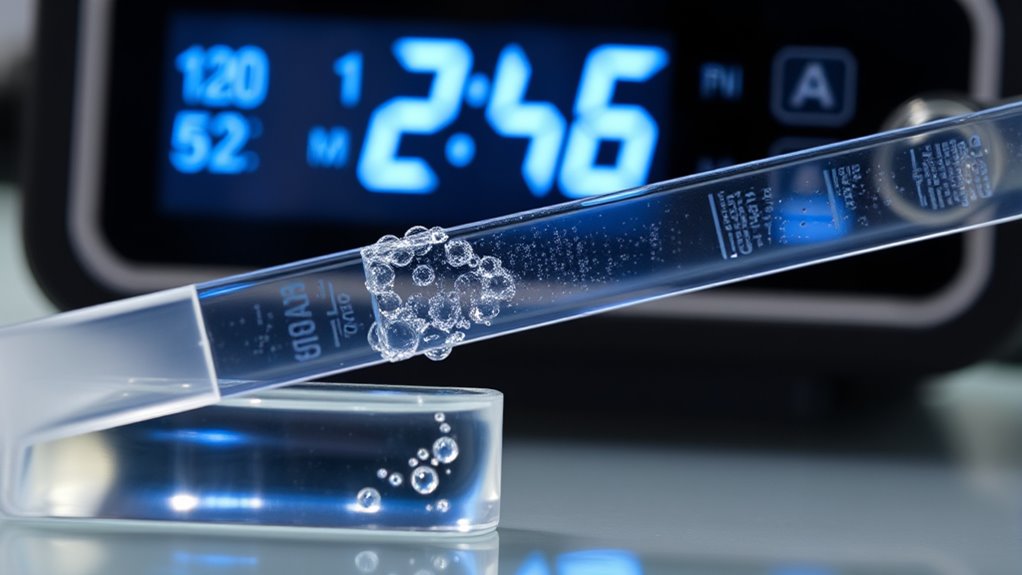
Testing for chloramine levels in your pool is essential to identify and address odors effectively. You’ll want to use test kits designed specifically for chloramines, which are available at pool supply stores. These kits typically include test strips or liquid reagents. To get an accurate reading, follow the instructions carefully and collect a water sample from mid-depth. Once you have your sample, dip the test strip or add the reagent, then compare the color change to the provided chart. Here’s a visual to help:
| Test Method | Sample Collection | Interpretation |
|---|---|---|
| Test Strips | Mid-depth water | Match color with chart |
| Liquid Reagents | Stir water sample | Note color change |
| Digital Tester | Direct water measurement | Read chloramine level |
Regular testing helps you monitor chloramine buildup and plan effective fixes.
Quick Methods to Reduce Chloramine Concentration
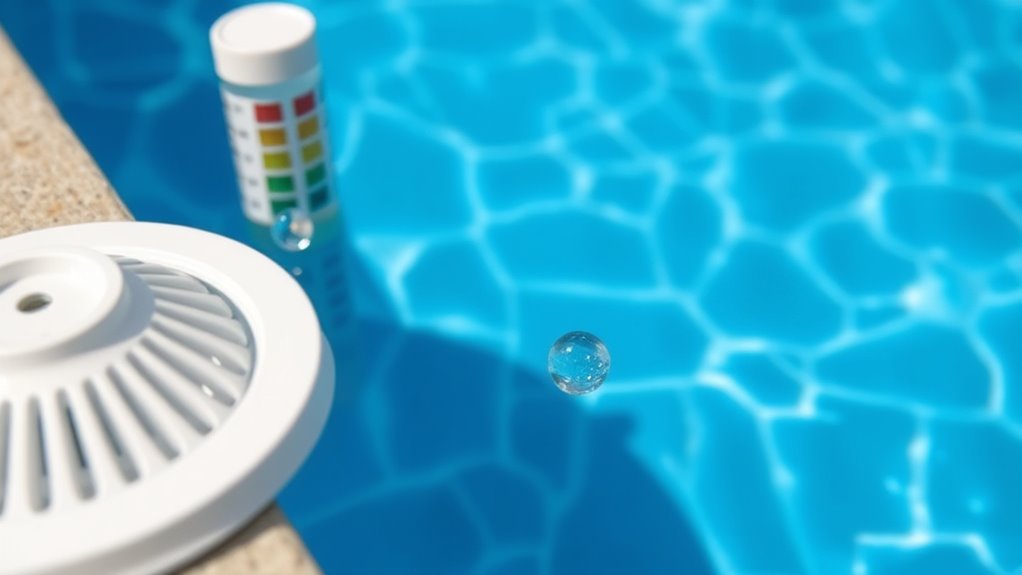
To quickly reduce chloramine levels, you can shock the pool with a high dose of chlorine, which breaks down the compounds. Increasing ventilation by opening windows or using fans helps disperse the odors and improves air quality. Additionally, using activated carbon filters can absorb chloramines from the water, providing rapid relief.
Shock the Pool
Shocking the pool is one of the quickest ways to reduce chloramine levels and eliminate unpleasant odors. When you add a strong chlorine shock, it breaks down chloramines, restoring water clarity and freshness. To do this effectively, use a high-quality pool shock product, following the manufacturer’s instructions closely. Make sure the pool pump runs constantly during and after shocking to circulate the chemicals thoroughly. Test your water afterward to ensure chlorine levels are safe before swimming. Shocking is especially helpful after heavy bather loads or if the chloramine smell persists.
Here are some quick tips:
- Use the right amount of shock based on pool size
- Shock during the evening or night for better absorption
- Keep the pool pump running constantly
- Avoid swimming until chlorine levels drop to safe levels
- Re-test water after 24 hours for ideal results
Use Activated Carbon
Using activated carbon is a quick and effective way to reduce chloramine levels in your pool. You can add it directly to your pool’s skimmer or use a dedicated filter containing activated carbon media. The carbon absorbs chloramines and other organic contaminants, helping to eliminate the foul odor and improve water quality. Make sure you select high-quality activated carbon designed for pool use, and follow the manufacturer’s instructions for dosage and replacement frequency. This method works best when combined with regular filtration and circulation, as it maximizes contact between the carbon and contaminated water. Keep in mind, activated carbon doesn’t remove all chloramines instantly, but it considerably speeds up the reduction process and improves water clarity. Regular maintenance ensures your pool stays fresh and odor-free.
Increase Ventilation
Have you considered increasing ventilation to quickly reduce chloramine levels in your pool? Improving airflow helps disperse chloramines trapped in the air, making the smell less noticeable and lowering irritations. You can achieve this by opening windows and doors around your pool area or using fans to circulate fresh air. Running exhaust fans can also pull chloramine-laden air out of the space more efficiently. Proper ventilation not only improves air quality but also helps maintain a healthier environment for swimmers and staff.
- Open windows and doors regularly
- Use high-capacity fans for better airflow
- Install exhaust fans to remove indoor air
- Keep the pool area well-ventilated during and after swimming
- Combine ventilation with other chloramine reduction methods
Best Practices for Maintaining Proper Pool Chemistry

Maintaining proper pool chemistry is essential for preventing chloramine buildup and ensuring safe, clear water. Regularly test your pool’s pH, alkalinity, and sanitizer levels using reliable test kits. Keep pH between 7.2 and 7.6 to optimize sanitizer effectiveness and reduce chloramine formation. Maintain sanitizer levels according to manufacturer guidelines, typically chlorine or bromine, to keep bacteria and contaminants at bay. Always balance alkalinity to prevent pH swings that can lead to instability. Consistent filtration and circulation help distribute chemicals evenly and remove debris that can fuel chloramine formation. Shower swimmers before entering to minimize contaminants. By proactively monitoring and adjusting your pool chemistry, you’ll create a healthier swimming environment and minimize odors caused by chloramines.
Using Shock Treatment to Eliminate Chloramines
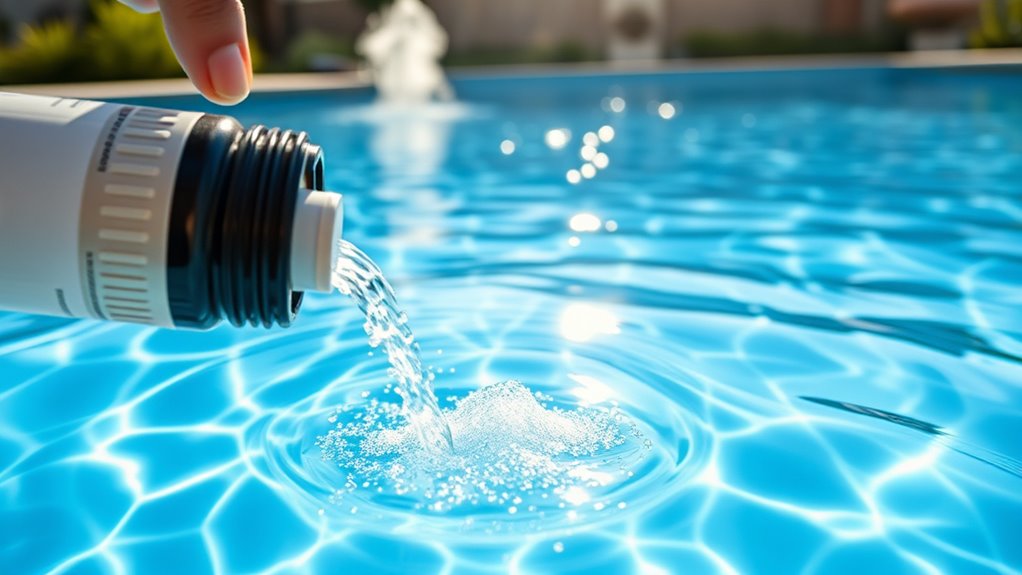
When chloramines accumulate and cause unpleasant odors or irritation, applying a shock treatment can effectively break them down. Shocking your pool involves adding a high dose of chlorine to rapidly oxidize chloramines, restoring water clarity and freshness. To use shock treatment successfully, follow the manufacturer’s instructions carefully. Typically, you’ll need to:
- Test your water to determine chlorine levels
- Choose the right type of shock (calcium or potassium)
- Distribute the shock evenly across the pool
- Run the pump to circulate the chemicals thoroughly
- Wait until chlorine levels drop before swimming again
Enhancing Filtration and Circulation Systems

Improving your pool’s filtration and circulation systems is essential for effectively reducing chloramine odors. A well-maintained filter traps contaminants, including organic compounds that produce odors, while good circulation ensures these pollutants don’t settle or build up in certain areas. Make sure your filter is clean and functioning properly—backwash or replace media as needed. Run your pump for at least 8-12 hours daily, especially during peak usage, to keep water moving and prevent chloramine formation. Consider upgrading to a higher-quality filter or adding a second skimmer if your pool is large. Proper circulation helps distribute chemicals evenly and flushes out chloramines, leading to fresher, clearer water. Consistent maintenance of these systems is key to controlling odors and maintaining healthy pool water.
Preventative Tips to Minimize Chloramine Formation

Regularly testing your pool water helps catch potential issues before chloramines form. By monitoring your water’s chemical levels, you can take quick action to prevent buildup. Maintaining proper chlorine levels is key—avoid under-chlorinating, which allows ammonia and organics to combine with chlorine, creating chloramines.
Here are some tips to minimize chloramine formation:
- Shock the pool regularly to break down chloramines
- Keep your pool well-ventilated to disperse volatile compounds
- Encourage bathers to shower before swimming to reduce contaminants
- Maintain proper pH levels to optimize chlorine effectiveness
- Regularly clean filters and skimmers to remove organic debris
Consistent maintenance and monitoring help keep your water clear, fresh, and free from persistent chloramine odors.
Frequently Asked Questions
How Often Should I Test for Chloramines in My Pool?
You should test for chloramines at least twice a week during peak swimming season, especially if your pool gets heavy use. Regular testing helps you catch any buildup early, preventing odors and irritation. If you notice a strong chemical smell or cloudy water, test immediately. Consistent testing and proper maintenance keep your pool safe, clear, and enjoyable for everyone.
Are Certain Pool Chemicals More Likely to Cause Chloramine Buildup?
Certain chemicals can certainly contribute to chloramine buildup, causing that telltale cloudiness and odor. You should watch out for high levels of combined chlorine from frequent use of shock treatments or algaecides, which can encourage chloramine formation. Additionally, overuse of cyanuric acid stabilizers might interfere with chlorine’s ability to disinfect properly. Be mindful of balancing your chemicals carefully, and always monitor chlorine and pH levels to prevent chloramine-related problems.
Can Pool Covers Influence Chloramine Formation and Odor?
Yes, your pool cover can influence chloramine formation and odor. When you cover your pool, it traps contaminants like sweat and oils from swimmers, which react with chlorine to form chloramines. Additionally, covers can reduce water circulation, allowing chloramines to accumulate. To minimize odors, make sure to regularly clean and remove your cover, maintain proper chlorine levels, and ensure good water circulation to prevent chloramine buildup.
What Are Natural Methods to Neutralize Chloramines Effectively?
You’re curious about natural ways to neutralize chloramines, right? Well, it’s not as simple as adding chemicals; nature offers some effective methods. You can try increasing aeration by running your pool’s waterfall or fountain, which helps off-gas chloramines. Using natural enzymes or adding leafy plants around the pool can also break down chloramines over time. These methods work gradually but are gentle, eco-friendly, and keep your water balanced.
How Does Weather Impact Chloramine Levels in Outdoor Pools?
Weather considerably impacts chloramine levels in outdoor pools. When it’s sunny and warm, sunlight breaks down chloramines faster, reducing their presence and odor. Conversely, rainy or overcast days can lower chlorine effectiveness, allowing chloramines to build up and cause stronger smells. Heavy rain can also dilute pool chemicals, making it harder to maintain proper balance. To keep chloramine levels in check, you should regularly test and adjust chlorine, especially during changing weather conditions.
Conclusion
By staying vigilant and maintaining your pool’s chemistry, you keep the water clear and inviting, like a sparkling mirror reflecting your best moments. When you understand chloramines and act swiftly, you prevent their dull, chemical smell from clouding your enjoyment. Think of your pool as a sanctuary—a place where pure, crisp water welcomes you like a breath of fresh breeze on a warm day. With care, your pool remains a invigorating escape, crystal clear and inviting every time.

